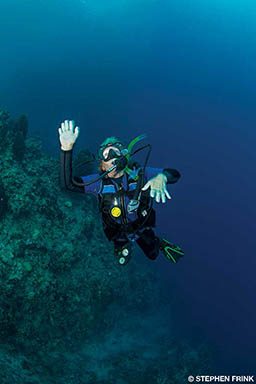When conditions took an abrupt and unexpected turn during an exotic warm-water dive, our dive leader decided to abort. His awareness of the group’s abilities, the worsening weather conditions and the intensifying sea state led him to make the first of several good decisions that were made that day.
As a group, we began to swim away from the reef where we had been diving at about 30 feet and headed toward the boat. I was at the back of the group when I realized I was often equalizing my ears. When I checked my depth gauge I saw that I had descended to 50 feet; in response I began finning harder and added a little air to my buoyancy compensator (BC). When my dive buddy looked back and gave me an OK sign, I responded with an OK.
I continued my efforts to ascend, keeping my eyes on the group, but I still needed to equalize frequently. I added more air to my BC and kicked harder, but I had dropped to 65 feet. I was caught in a down current and couldn’t break free of it.
When my dive buddy checked on me again, I let him know there was a problem, so he came to my aid. We linked arms and together kicked our way out of the down current, eventually joining the group during their safety stop. Later he said he was concerned we may have ascended too fast, but his dive computer confirmed what I already knew — getting to a shallower depth took work. The whole event transpired in about two and a half minutes.

Several elements contributed to this positive outcome. First, I recognized there was a problem and took action. By finning harder and adding air to my BC, I resisted the pull of the down current. While my training and experience suggested that I move closer to the reef to get some relief from the strong current, the circumstances did not provide that option because we were in open water.
Second, when my efforts were not getting the desired result, I asked for help. Together, my dive buddy and I had the strength to break free from the down current.
Third, my dive buddy remained close by and was paying attention, so he was able to provide the assistance I needed. Diving without a buddy or being separated from the group could have led to a disastrous outcome in this situation.
Staying calm and considering options are significant parts of any problem resolution. By the time my buddy came to my assistance, I still had time to drop my weights. I was not low on air, and I had not reached a critical depth for the nitrox mix I was breathing. Timely actions broke the chain of events and prevented escalation of the problem.
Situational awareness is the overarching skill required to dive safely and respond quickly. In this event, both my rescuer and I were paying attention and were therefore able to avert an incident. Rescue skills do not just involve helping other divers. Self-rescue capabilities — as well as knowing when you need help and being willing to ask for it — are just as important.
| © Alert Diver — Q3 2018 |